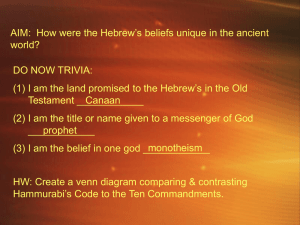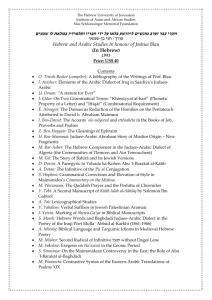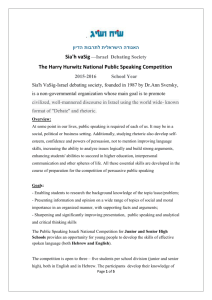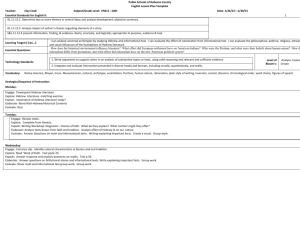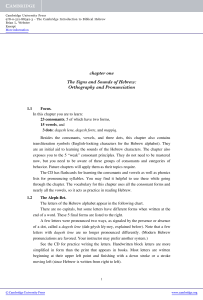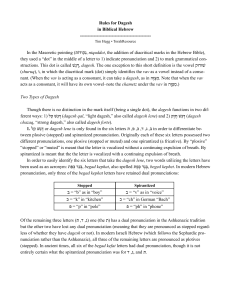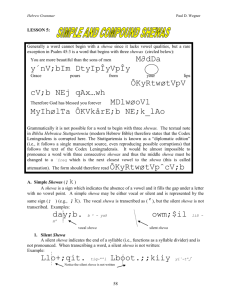Hebrew Grammar - FarAboveAll.com
advertisement
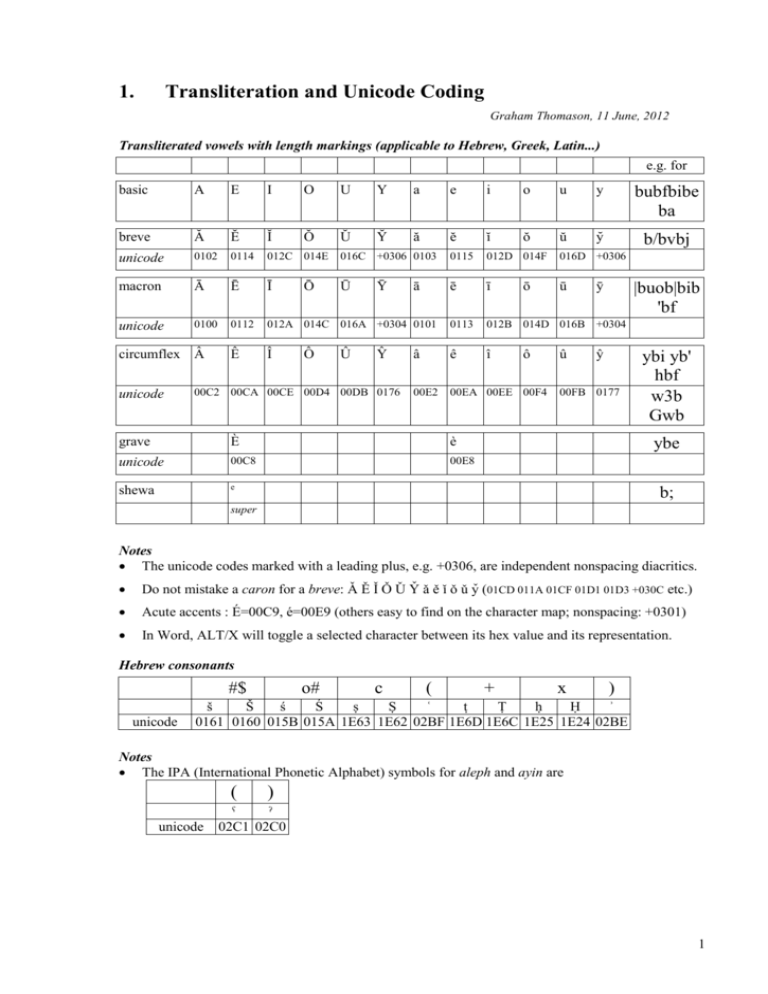
1. Transliteration and Unicode Coding Graham Thomason, 11 June, 2012 Transliterated vowels with length markings (applicable to Hebrew, Greek, Latin...) e.g. for basic A E I O U Y a e i o u y bubfbibe ba breve Ă Ĕ Ĭ Ŏ Ŭ Y̆ ă ĕ ĭ ŏ ŭ y̆ b/bvbj unicode 0102 0114 012C 014E 016C +0306 0103 0115 012D 014F 016D +0306 macron Ā Ē Ī Ū ē ī ū unicode 0100 0112 012A 014C 016A +0304 0101 0113 012B 014D 016B +0304 Ê Î â ê î 00E2 00EA 00EE 00F4 circumflex  unicode Ō Ô Û Ȳ Ŷ 00C2 00CA 00CE 00D4 00DB 0176 ā grave È è unicode 00C8 00E8 shewa e ō ô û ȳ |buob|bib 'bf ŷ 00FB 0177 ybi yb' hbf w3b Gwb ybe b; super Notes The unicode codes marked with a leading plus, e.g. +0306, are independent nonspacing diacritics. Do not mistake a caron for a breve: Ǎ Ě Ǐ Ǒ Ǔ Y̌ ǎ ě ǐ ǒ ǔ y̌ (01CD 011A 01CF 01D1 01D3 +030C etc.) Acute accents : É=00C9, é=00E9 (others easy to find on the character map; nonspacing: +0301) In Word, ALT/X will toggle a selected character between its hex value and its representation. Hebrew consonants #$ unicode o# c ( + x ) š Š ś Ś ṣ Ṣ ʿ ṭ Ṭ ḥ Ḥ ʾ 0161 0160 015B 015A 1E63 1E62 02BF 1E6D 1E6C 1E25 1E24 02BE Notes The IPA (International Phonetic Alphabet) symbols for aleph and ayin are ( unicode ) ˁ ˀ 02C1 02C0 1 2. 1 2a 2b 3a 3b 4a 4b 5 6 7 8 9 10 11a 11b 12 13 14 15 16 17a 17b 18 19 20 21a 2 The Alphabet Hebr Hand- Hebrew Trans- Popular Scholarly AV Remarks square written name literation name translit- translitof name eration eration aleph ʾ a glottal plosive ʾālep Ple)f ) ) b% b% b b g@ g@ g g d% d% d d h h w w z z x + y K@ k% Kk l M m Nn s ( P3 pZ Pp Cc q r o# x + y K@ k% Kk l M m Nn s ( P3 pZ Pp Cc q r o# tyb%' lmeyg @I bêt gîmel beth gimel B b (+bb) b b Bb originally bilabial (?) modern pronunciation is v g G g (+gg) g Gg tledf% dālet daleth b g D d (+dd) d Dd d originally a velar fricative modern pronunciation is g d originally voiced th modern pronunciation is d h hēʾ hé Hh h wwF wāw waw Ww v NyIz A tyx' zayin zayin Zz z originally w (?) modern pronunciation is v z ḥêt heth Ḥḥ h a pharyngeal unvoiced fricative ty+' ṭêt teth Ṭṭ t pharyngealized t dowy yôd yod Yy j/i y Pk%f kāp kaph K k (+kk) c k Kk ch a velar fricative )h' dmelf lāmed lamed Ll l l Mm' mēm mem Mm m m Nw3n nûn nun Nn n n Kmesf sāmek samekh S s s s NyI(a ʿayin ayin ʿ - a pharyngeal voiced fricative pēh pé P p (+pp) p p Pp ph modern pronunciation is f hpZ' yd'cf ṣādê tsadé Ṣṣ z Powq qôp qoph Qq k originally pharyngealized s modern pronunciation is ts. a uvular voiceless plosive #$yr' rêš resh Rr r rolled or uvular Ny#i$ śîn sin Śś s s, not distinguished from 21b 22a 22b #$ tZ t #$ tZ t Nyo#i šîn shin Šš sh samekh sh wtaZ taw taw T t (+tt) t t Tt th originally voiceless th 3 Notes on the alphabet The Hebrew alphabet consists of 22 basic consonants. The other consonants are variations of the 22 fundamental consonants. The handwritten forms are in imitation of printed letters, which is as Biblical Hebrew is normally taught, and are not the way Modern Hebrew is normally written (which is rather different). Six letters (tpkdgb) have a hard and soft form. In pointed script, the hard form takes a dot or dagesh (tpZk%d%g@b%) whereas the soft form does not (tpkdgb). These two forms are not regarded as separate letters, and do not have separate dictionary ordering. One must also distinguish o Dagesh lene. A dagesh lene will always be present when no vowel precedes the consonant. o Dagesh forte. If there is a dagesh when a vowel precedes the consonant, it is a dagesh forte, in which case the transliteration will be a double letter. Although the soft forms are transcribed in the same way as the hard forms with dagesh lene, the forms (including when reading a transcription) can be read with a soft (fricative) pronunciation, so e.g. p will be read as f. o# and #$ are counted as one letter and do not (traditionally) have separate dictionary ordering. Five letters (cpnmk) have separate final forms (CPNMK). These are used at the end of a word. Identical sounds in modern Hebrew o o o o o o o o o )( bw k% q kx g g@ d d% s o# t t@ + c st stZ s+ o#t o#tZ o#+ but these are distinguished o b% b o k% k o pZ p 4 Some other fonts Hebrew Square ) b g d h w z x + y Kk l Mm Nn s ( Pp Cc q r o# #$ t Siloam / Samaritan Qumran Palaeo Rabbinic (Rashi) Handwritten Square Modern cursive ) b g d h w z x + y Kk l Mm Nn s ( Pp Cc q r o# #$ t ) b g d h w z x + y Kk l Mm Nn s ( P p3 Cc q r o# #$ t ) b g d h w z x + y k l m n s ( p c q r # ) b g d h w z x + y k l m n s ( p c q r # ) b g d h w z x + y Kk l Mm Nn s ( Pp Cc q r # ) b g d h w z x + y Kk l m n s ( Pp Cc q r # t t t t 5 Meanings of the letters and gematria Hebrew Square Hebrew Name ) b g d h w z x + y k l m n s ( p c q r o# #$ t K M N P C Ple)f tyb%' lmeyg@I tledf% )h' wwF NyIzA tyx' ty+' dowy Pk%f dmelf Mm' Nw3n K7mesf NyI(a hpZ' yd'cf Powq #$yr' Ny#i$ Nyo#i wtaZ 6 Meaning Gematria Ox 1 House Camel 2 3 Door 4 Window Hook 5 6 Weapon Fence Snake 7 8 9 Hand 10 Palm of hand 20 Goad 30 Water 40 Fish Prop 50 60 Eye 70 Mouth Fish-hook? Eye of needle? 80 90 100 Head 200 Tooth (same) 300 (same) Cross 400 500 600 700 800 900 2.1 Vowels Summary of the vowels A long with mater lectionis E I O U hb yb yb G w f% '% %i w 3b b % % bâ bê bî bô bû long without mater lectionis shewa b b b b b %a % %i % % e f u ba be bi bo bu hurried b b |b ob |b %f %' %i % % u bā bē bī bō bū short b b %j % v b %/ bă bĕ bŏ b@ %; be long e grave ybe % bè 7 Detailed Table of vowels with Hebrew names, transliterated names and informal names. A long with mater bâ long without mater b %f lectionis bā short hb f% lectionis E Cmeqf qāmeṣ qamets hurried patach chateph pataḥ shewa U ḥôlem gādôl bê tseré gadol bî chireq gadol bô cholem gadol bû shureq ob % Mleowx |b Cw3b % %qi u qibbûṣ bō cholem bo qamets chatuph b %' yr'c' bē tseré be ṣērê lowgs; e s gôl segol lowgs; P+'xf ḥātēp segôl bĕ chateph segol |b %i qreyxi bī chireq ḥîreq b %i qreyxi bi chireq ḥîreq lowdgF Mleowx w qrew 3b 3#$ % šûreq b xtapaZ b %j P+'xf % ḥātēp pataḥ v bă O yb lowdgF yb lowdgF G '% yr'c' %i qreyxi w ṣērê gādôl ḥîreq gādôl b % b xtapaZ b %a pataḥ % e ba I ḥôlem bū qibbuts b Pw3+xf Cmeqf b Cw3b % qāmeṣ ḥātûp % %qi f u qibbûṣ b Pw3+xf Cmeqf %/ P+'xf bu qibbuts ḥātēp qāmeṣ ḥātûp bŏ chateph qamets chatuph b )wF#;$ @ šewaʾ %; be shewa long e grave yb lowdgF e lowgs; % segôl gādôl bè segol gadol Notes 1. Generally, hbf% (bâ) will only occur at the end of a word; elsewhere bf% (bā) is used. 2. There are some (rather complex) ways to distinguish between bf%= bā and bf%=bo, e.g. Word pattern (short closed unstressed syllable) + (stressed syllable [open/closed long/short]): hmfk;xf (ḥokmâ) (wisdom), l+aq;hf (hoqṭal) (he was caused to be killed) A meteg, as in w3bt;|k%f (kātevû) (they wrote) indicates an ā. Standard grammatical forms reveal the vowel, e.g. hofal btZak;hfû from btak%f and Mkey#$'d;xûf from #$deox. 3. Transliterate bāh. 8 hb'% by bēh, hbe% and h@be% both by beh, )b%f by bāʾ, and h@b%f by 4. As in precise orthography, the GGTAmos font can distinguish, by the position of the dot, a consonantal waw+ ḥôlem (ow) from a vocalic ḥôlem on o mater lectionis (Gw). 5. As in precise orthography, the GGTAmos font can distinguish, by the position of the dot, a consonantal waw with dagesh (w[) from a šûreq (w3). 6. The GGTAmos font can distinguish, by a convention, bf%=bā from bf%û=bo. 9
